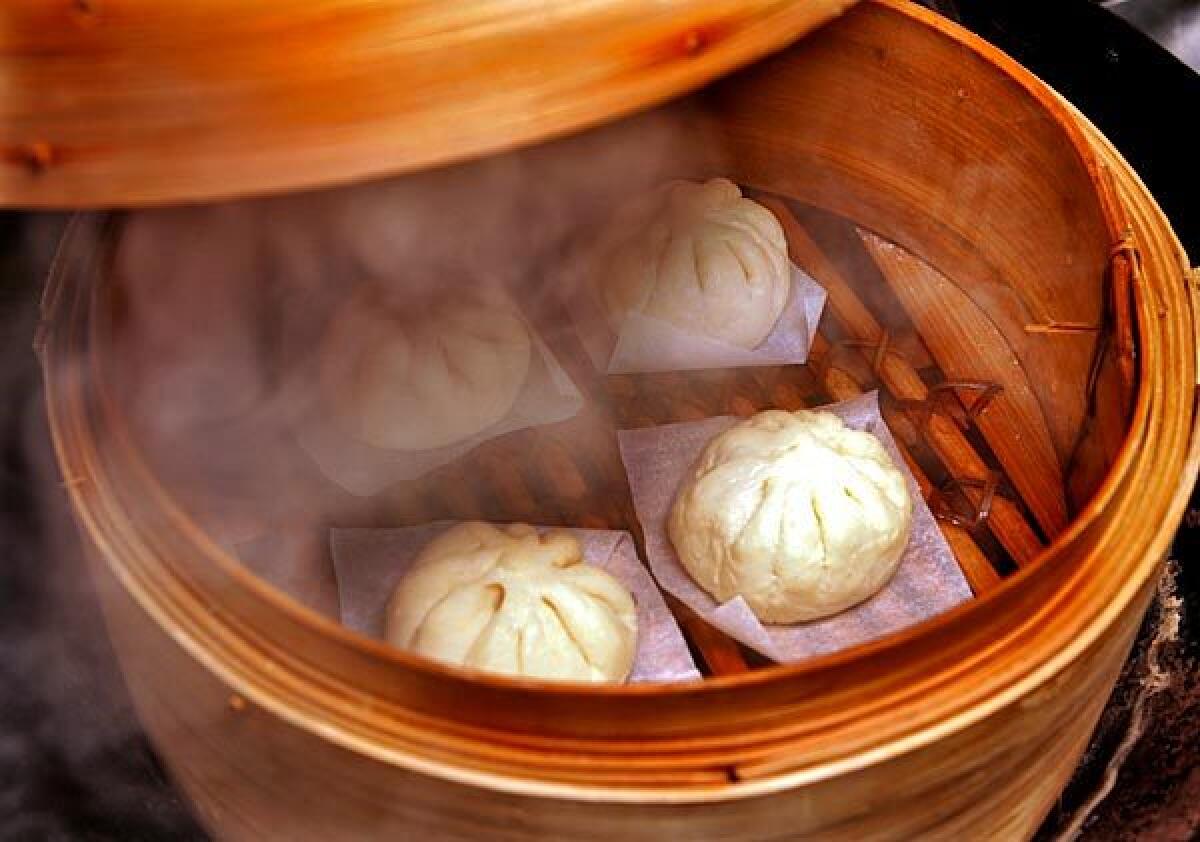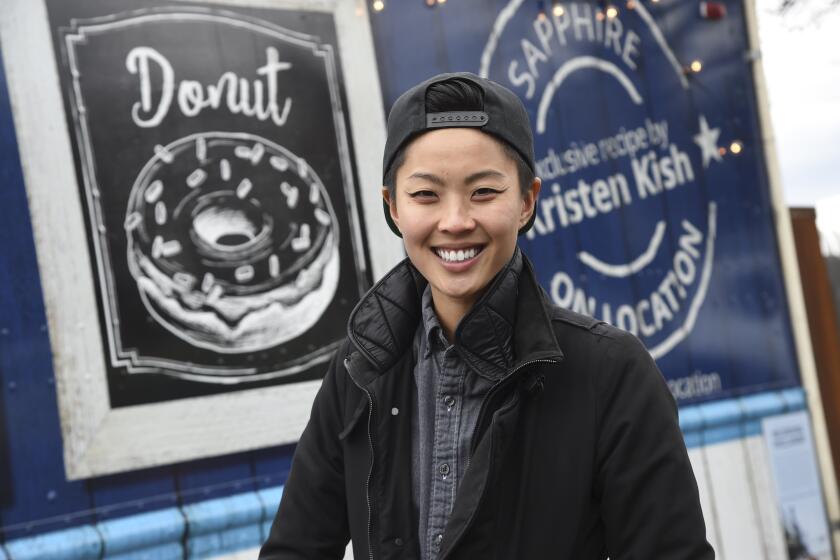The trick to making bao? Starting with the perfect dough

- Share via
You can tell when a dish has made it into the mainstream by looking it up in the dictionary. There you’ll find entries for sushi, taco and pho. I still have to italicize as a foreign word bao, the term for Chinese steamed bread and filled buns, but my hunch is that I won’t have to do that for long.
Bao is on the rise, and that’s not just because it features leavened dough. Just check Costco, supermarket chains such as Vons/Pavilions and Ralphs, and of course, any nearby 99 Ranch. It’s not hard to find bao in the frozen or refrigerated food sections.
Convenient as they are, packaged buns are never as satisfying as homemade ones -- freshly steamed, chewy-soft and filled with fragrant roast pork or curried chicken redolent of spices.
Steamed, filled buns originated in China, perhaps as early as the third century AD. They have since spread throughout East and Southeast Asia and were brought to the U.S. by immigrants. I’m thrilled that bao has moved beyond Chinatown excursions into everyday American eating.
I’ve been infatuated with bao since childhood. Using self-rising flour, sugar and milk for the dough, my mother made a Vietnamese rendition filled with a stir-fried pork-and-vegetable mixture, a wedge of boiled egg and slices of Cantonese roast pork and lap cheung (sausage). I enjoyed them for breakfast and lunch dipped in a pool of soy sauce and lots of black pepper.
On the weekends, our family drove from San Clemente to Chinatown in Los Angeles for dim sum breakfasts at the long-defunct Tai Hong restaurant on Broadway. There I learned to carefully listen to the dumpling ladies’ melodious calls advertising their char siu bao, my favorite kind. The classic Cantonese bao were snowy white, pillowy soft and savory-sweet with the goodness of chopped roast pork inside. Those buns made me swoon, and I always sneaked an extra one from the bamboo steamer.
The stuffed buns from my mom’s kitchen and dim sum houses defined my bao world for decades. I was perfectly satisfied during my youth, but then had an epiphany as a young adult.
A bao revelation
While studying in Hong Kong on a fellowship in the early 1990s, I traveled to Dali, a town in southwestern China. There I experienced bao like none that I had ever tasted before. They were diminutive, the size of golf balls, filled with juicy ground pork and encased by remarkably spongy, slightly chewy dough. The game changer was not the filling, which I could get my head around, but rather the dough.
In raw form, it sat on the bun maker’s counter as an active, somewhat mischievous blob. The ecru-colored dough was alive with yeasty goodness. At home, I’d been delighted by bao made from overly white, cakey, sweet dough. This dough looked different and, as it turned out, produced superior bao. It was the first time that I’d ever detected wheat flour’s natural savor in bao. Additionally, the Dali dough wasn’t cloying and it allowed the filling to really pop. There were 10 bao per order, and my friends and I enjoyed multiple orders daily during our weeklong stay. That Dali bao quickly became my benchmark for perfection, and it had to do with the dough.
When I returned to the U.S., I began looking for similar dough in commercial Chinese steamed bao but did not find it until I started experimenting on my own. I quickly discovered that bao dough was tricky to master, despite the fact that just a handful of ingredients went into it: wheat flour, leavening, liquid, fat and sugar.
Bao dough is akin to Western bread dough, the difference being that the cooking method is wet steam heat. For the most part, when bao dough is steamed into plain buns or rolls (the kind you’d tuck a slice of roast duck or pork belly into), they puff up nicely and cook to a wonderful fluffy finish.
The problem arises when the dough is stuffed to make filled buns. Whether the filling is raw or cooked, it introduces moisture into the bun during steaming and can cause the dough to cave in or wrinkle after cooking. Imagine my devastation on the occasions when that happened after hours of working and waiting.
The preventive measures prescribed in cookbooks, such as carefully lifting the steamer lid after the buns are done so that moisture doesn’t drip back onto them, failed me. Plus, that’s not what I observed at dim sum houses and street stalls in Asia, where professional cooks lifted their steamer lids with little care, steam wafting up from below, to serve you a hot bao.
Over the years, I’ve test-driven recipes from many Asian cookbooks, including some devoted to the craft of making Chinese doughy treats. Along the way, I’ve tried dough using starters and employed potassium carbonate solution and Chinese baking powder sold at Asian markets, but the results were either not as light as I wanted or ended up tasting metallic. I’ve kneaded baking powder into the dough at the end in an attempt to achieve a lofty rise; it worked but the bao surface became dimpled.
I’ve carted flour home from Singapore and purchased Taiwanese flour from 99 Ranch that featured bao photos on the packaging. Low-gluten American cake flour and renowned White Lily flour milled from soft winter wheat have found their way into my bao dough experiments. These bleached, low-gluten flours yield bright white dough that unfortunately tasted flat.
Keeping it simple
At the end of the day, the best and easiest bao dough is simply made by stirring together these readily available ingredients: moderate gluten all-purpose flour from the supermarket, instant (fast-acting) yeast, baking powder, canola oil, sugar and water. I often knead by hand, but when I feel lazy, I let the food processor do the work. Regardless of method, the result is fabulous.
The dough cooks up to a fluffy tenderness but with a slight chew, like the Dali dough, and doesn’t collapse under the pressures of steaming. When developing the recipes for my cookbook, “Asian Dumplings,” I nervously tested the dough to make pan-fried stuffed buns (sheng jian baozi), a Shanghai favorite that is like a cross between pot stickers and bao. Cooked in a skillet, the dough amazingly performed without a glitch.
The key is having a little fat and combining yeast with baking powder in a balanced proportion. As biochemist and acclaimed author Shirley Corriher explains in “Cookwise,” working in a small amount of fat tenderizes and enables bread dough to hold gas bubbles well. That lightens the dough, she says, as does employing a two-pronged approach to leavening.
With reliable, delectable bao dough, it is just a matter of picking a filling, stuffing and then steaming. It’s been more than 17 years since I was in Dali. Who would have thought that all the ingredients to produce sensational bao were at my fingertips?
More to Read
Eat your way across L.A.
Get our weekly Tasting Notes newsletter for reviews, news and more.
You may occasionally receive promotional content from the Los Angeles Times.










